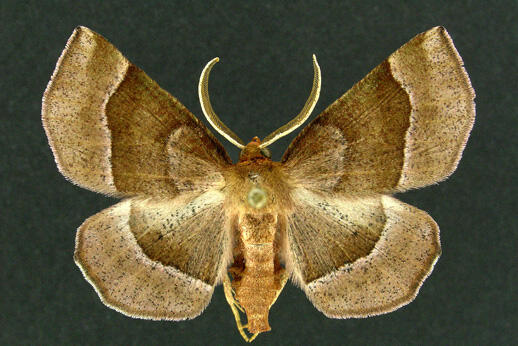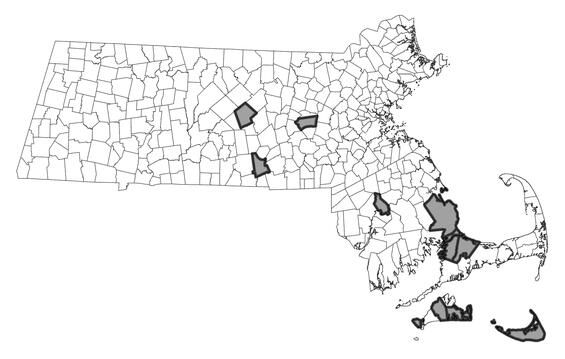- Scientific name: Metarranthis pilosaria
- Species of Greatest Conservation Need (MA State Wildlife Action Plan)
- Special Concern (MA Endangered Species Act)
Description

Heath metarranthis (Metarranthis pilosaria)
The heath metarranthis (Metarranthis pilosaria) is a geometrid moth with a wingspan of 29-35 mm (1.1-1.4 in; Rupert 1943). Both the forewing and the hind wing have a smoothly curved postmedial line that is dark brown to black proximally and light, pinkish-tan to white distally. Both the forewing and the hind wing are reddish-brown proximal to the postmedial line and pinkish-tan distal to it. The forewing has a light, pinkish-tan antemedial line. The reniform spot is absent, and the discal spot small and black. Both the forewing and the hind wing are peppered with black, and bright orange on the underside. The head and thorax are concolorous with the proximal portion of the wings; the abdomen is lighter, similar in color to the distal portion of the wings. The barrens metarranthis (Metarranthis apiciaria), an endangered species in Massachusetts, has a similar wing pattern, but overall it is lighter brown above, and on the underside it is not bright orange like the heath metarranthis.
Life cycle and behavior
In Massachusetts, adult heath metarranthis moths fly from early June to early July. Larvae feed through the summer on blueberries and cranberries (Vaccinium spp.), and probably also leatherleaf (Chamaedaphne calyculata). Larvae pupate in September, and the pupa overwinters.

Distribution and abundance
The heath metarranthis is endemic to Massachusetts, Rhode Island, Long Island, New York, and southern New Jersey (NatureServe 2025). In Massachusetts it is found on the southeastern coastal plain and in a few inland bogs.

Distribution in Massachusetts.
2000-2025
Based on records in the Natural Heritage Database.
Habitat
In Massachusetts, the heath metarranthis inhabits sandplain pitch pine-scrub oak barrens and heathlands, as well as acidic swamps and bogs.
Healthy habitats are vital for supporting native wildlife and plants. Explore habitats and learn about conservation and restoration in Massachusetts.

Sandplain pitch pine-scrub oak barrens habitat with sparse trees and abundant lowbush blueberries, ideal habitat for the heath metarranthis. Habitat managed by MassWildlife at Southeast Pine Barrens Wildlife Management Area.
Threats
The heath metarranthis is threatened by habitat loss and fire suppression in its disturbance-dependent habitats, in particular sandplain pitch pine-scrub oak barrens and heathlands. Other potential threats include introduced generalist parasitoids, aerial insecticide spraying, non-target herbicide application, and off-road vehicles. In its wetland habitats, hydrologic alteration, invasion by exotic plants, and eutrophication or other water pollution are potential threats. A warming climate may be detrimental to this species, as its range has a very narrow latitudinal extent, extending south only to New Jersey. Northward range expansion may be possible, though this has not yet been documented.
Conservation
Land protection and habitat management are the primary conservation needs of this species in Massachusetts. In particular, sandplain pitch pine-scrub oak barrens and heathlands should be conserved, restored, and managed to maintain habitat for this species and the entire suite of rare and threatened species dependent on such habitats.
Survey and monitoring
The distribution of heath metarranthis in sandplain pitch pine-scrub oak barrens and heathlands, as well as acidic swamps and bogs, is well documented. Known populations of this species should be surveyed to document persistence at least once every 25 years; every 10 years is more desirable when practicable.
Management
Management of sandplain pitch pine-scrub oak barrens and heathlands benefits a suite of rare and threatened species, and habitat condition should be monitored and management adapted as needed. For the heath metarranthis, open barrens with a shrub layer including lowbush blueberries (Vaccinium angustifolium and V. pallidum) is of particular importance. This species also benefits from reclamation of cranberry bogs and restoration to open, acidic wetlands.
Research needs
The natural history and conservation needs of the heath metarranthis are relatively well known. However, the future effects of a warming climate on this species are unpredictable and should be documented.
References
NatureServe. 2025. NatureServe Network Biodiversity Data accessed through NatureServe Explorer [web application]. NatureServe, Arlington, Virginia. Available https://explorer.natureserve.org/. (Accessed: January 14, 2025).
Rupert, L.R. 1943. A specific revision of the genus Metarranthis (Lepidoptera, Geometridae, Ennominae). Journal of the New York Entomological Society 51(3): 133-159.
Contact
| Date published: | March 7, 2025 |
|---|